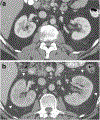Imaging features of immune checkpoint inhibitor-related nephritis with clinical correlation: a retrospective series of biopsy-proven cases
- PMID: 36255488
- PMCID: PMC9957799
- DOI: 10.1007/s00330-022-09158-8
Imaging features of immune checkpoint inhibitor-related nephritis with clinical correlation: a retrospective series of biopsy-proven cases
Abstract
Objectives: Imaging appearances of immune checkpoint inhibitor-related nephritis have not yet been described. The primary objective of this study is to describe the appearances of immunotherapy-related nephritis on computerized tomography (CT) and positron emission tomography (PET). The secondary objectives are to investigate the association of radiologic features with clinical outcomes.
Methods: CT and PET-CT scans before the initiation of immunotherapy (baseline), at nephritis, and after resolution of pathology-proven nephritis cases were reviewed. Total kidney volume, renal parenchymal SUVmax, renal pelvis SUVmax, and blood pool SUVmean were obtained.
Results: Thirty-four patients were included. The total kidney volume was significantly higher at nephritis compared to baseline (464.7 ± 96.8 mL vs. 371.7 ± 187.7 mL; p < 0.001). Fifteen patients (44.1%) had > 30% increase in total kidney volume, which was associated with significantly higher renal toxicity grade (p = 0.007), higher peak creatinine level (p = 0.004), and more aggressive medical treatment (p = 0.011). New/increasing perinephric fat stranding was noted in 10 patients (29.4%) at nephritis. Among 8 patients with contrast-enhanced CT at nephritis, one (12.5%) developed bilateral wedge-shaped hypoenhancing cortical. On PET-CT, the renal parenchymal SUVmax-to-blood pool ratio was significantly higher at nephritis compared to baseline (2.13 vs. 1.68; p = 0.035). The renal pelvis SUVmax-to-blood pool SUVmean ratio was significantly lower at nephritis compared to baseline (3.47 vs. 8.22; p = 0.011).
Conclusions: Bilateral increase in kidney size, new/increasing perinephric stranding, and bilateral wedge-shaped hypoenhancing cortical foci can occur in immunotherapy-related nephritis. On PET-CT, a diffuse increase in radiotracer uptake throughout the renal cortex and a decrease in radiotracer activity in the renal pelvis can be seen.
Key points: • CT features of immune checkpoint inhibitor-related nephritis include an increase in kidney volume, new/increasing perinephric stranding, and bilateral ill-defined wedge-shaped hypoenhancing cortical foci. • FDG-PET features of immune checkpoint inhibitor-related nephritis include an increase in FDG uptake throughout the renal cortex and a decrease in FDG activity/excretion in the collecting system. • > 30% increase in total kidney volume is associated with worse toxicity grade and more aggressive medical management.
Keywords: Immunotherapy; Nephropathy; Radiographic; Radiology; Toxicity.
© 2022. The Author(s), under exclusive licence to European Society of Radiology.
Conflict of interest statement
Conflicts of interest:
N.A. has received honoraria for serving on a scientific advisory board as a consultant for ChemoCentryx. A.D. has received honoraria from Nektar and he has served as a consultant for Nektar, Memgen and Pfizer.
Figures




Similar articles
-
More advantages in detecting bone and soft tissue metastases from prostate cancer using 18F-PSMA PET/CT.Hell J Nucl Med. 2019 Jan-Apr;22(1):6-9. doi: 10.1967/s002449910952. Epub 2019 Mar 7. Hell J Nucl Med. 2019. PMID: 30843003
-
Immunotherapy-related renal toxicity causes reversible renal enlargement.Abdom Radiol (NY). 2022 Sep;47(9):3301-3307. doi: 10.1007/s00261-022-03594-2. Epub 2022 Jul 1. Abdom Radiol (NY). 2022. PMID: 35776145
-
Use of Fluoro-[18F]-Deoxy-2-D-Glucose Positron Emission Tomography/Computed Tomography to Predict Immunotherapy Treatment Response in Patients With Squamous Cell Oral Cavity Cancers.JAMA Otolaryngol Head Neck Surg. 2022 Mar 1;148(3):268-276. doi: 10.1001/jamaoto.2021.4052. JAMA Otolaryngol Head Neck Surg. 2022. PMID: 35050348 Free PMC article. Clinical Trial.
-
The value of FDG PET/CT imaging in outcome prediction and response assessment of lymphoma patients treated with immunotherapy: a meta-analysis and systematic review.Eur J Nucl Med Mol Imaging. 2022 Nov;49(13):4661-4676. doi: 10.1007/s00259-022-05918-2. Epub 2022 Aug 6. Eur J Nucl Med Mol Imaging. 2022. PMID: 35932329 Free PMC article.
-
Prognostic value of 18F-FDG PET/CT in patients with advanced or metastatic non-small-cell lung cancer treated with immune checkpoint inhibitors: A systematic review and meta-analysis.Front Immunol. 2022 Nov 17;13:1014063. doi: 10.3389/fimmu.2022.1014063. eCollection 2022. Front Immunol. 2022. PMID: 36466905 Free PMC article.
Cited by
-
Clinical Implications of Striated Nephrogram in Patients Receiving Immune Checkpoint Inhibitors for Cancer.Kidney Med. 2025 May 29;7(8):101038. doi: 10.1016/j.xkme.2025.101038. eCollection 2025 Aug. Kidney Med. 2025. PMID: 40740732 Free PMC article. No abstract available.
-
A New Era for PET/CT: Applications in Non-Tumorous Renal Pathologies.J Clin Med. 2024 Aug 7;13(16):4632. doi: 10.3390/jcm13164632. J Clin Med. 2024. PMID: 39200774 Free PMC article. Review.
-
Novel Biomarkers and Imaging Tests for Acute Kidney Injury Diagnosis in Patients with Cancer.Kidney360. 2025 Jan 1;6(1):167-174. doi: 10.34067/KID.0000000660. Epub 2024 Nov 21. Kidney360. 2025. PMID: 39575585 Free PMC article. Review.
-
Is 18F-FDG-PET/CT an Optimal Imaging Modality for Detecting Immune-Related Adverse Events after Immune-Checkpoint Inhibitor Therapy? Pros and Cons.Cancers (Basel). 2024 May 24;16(11):1990. doi: 10.3390/cancers16111990. Cancers (Basel). 2024. PMID: 38893111 Free PMC article. Review.
-
Immunological mechanisms underlying clinical phenotypes and noninvasive diagnosis of immune checkpoint inhibitor-induced kidney disease.Immunol Rev. 2023 Sep;318(1):61-69. doi: 10.1111/imr.13243. Epub 2023 Jul 21. Immunol Rev. 2023. PMID: 37482912 Free PMC article. Review.
References
MeSH terms
Substances
Grants and funding
LinkOut - more resources
Full Text Sources
Medical

